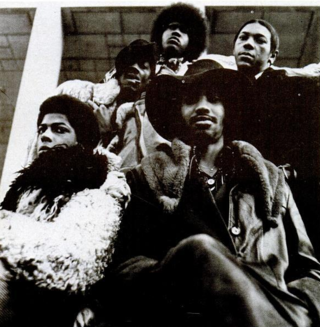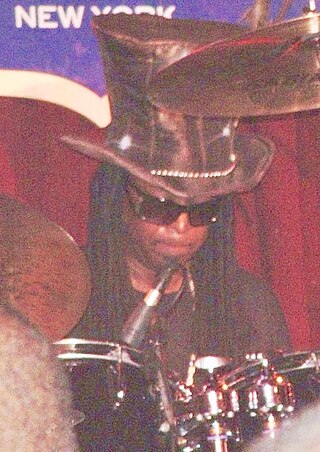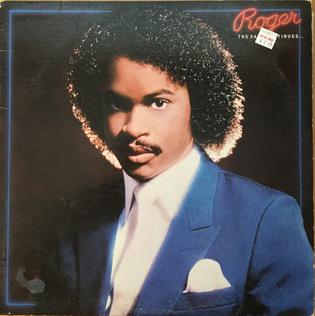
Parliament-Funkadelic is an American music collective of rotating musicians headed by George Clinton, primarily consisting of the funk bands Parliament and Funkadelic, both active since the 1960s. Their eclectic style drew on psychedelia, outlandish fashion, and surreal humor. They released albums such as Maggot Brain (1971), Mothership Connection (1975), and One Nation Under a Groove (1978) to critical praise, and scored charting hits with singles such as "Tear the Roof Off the Sucker" (1975) and "Flash Light" (1978). Overall, the collective achieved thirteen top ten hits in the American R&B music charts between 1967 and 1983, including six number one hits. Their work would have an influential effect on subsequent funk, post-punk, hip-hop, and techno artists of the 1980s and 1990s, while their collective mythology would help pioneer Afrofuturism.

Funkadelic was an American funk rock band formed in Plainfield, New Jersey in 1968 and active until 1982. As one of the two flagship groups of George Clinton's P-Funk collective, they helped pioneer the funk music culture of the 1970s. Funkadelic initially formed as a backing band for Clinton's vocal group the Parliaments, but eventually pursued a heavier, psychedelic rock-oriented sound in their own recordings. They released acclaimed albums such as Maggot Brain (1971) and One Nation Under a Groove (1978).

Hardcore Jollies is the ninth studio album by the funk rock band Funkadelic, released on October 29, 1976 by Warner Bros. Records, their first album to be issued on a major label. It is dedicated to "the guitar players of the world." Originally, the first side of the album was called "Osmosis Phase 1" and the second side was "Terribitus Phase 2." Hardcore Jollies was released one month after Funkadelic's final album for Westbound Records, Tales of Kidd Funkadelic, which was recorded during the same sessions.

William Earl "Bootsy" Collins is an American bass guitarist, singer-songwriter, and record producer.

The Electric Spanking of War Babies is the twelfth studio album by the American funk rock band Funkadelic, released in April 1981 on Warner Bros. Records. The title is an allusion to the Vietnam War and baby boomers. Sly Stone contributed to the recording sessions, singing lead vocals on "Funk Gets Stronger ".

Stretchin' Out in Bootsy's Rubber Band is the first album by American funk and soul band Bootsy's Rubber Band, an offshoot act of Parliament-Funkadelic led by bassist and vocalist William "Bootsy" Collins. It was released on January 30, 1976, on Warner Bros. Records.

Roger Troutman was an American singer, songwriter, record producer, multi-instrumentalist and the founder of the band Zapp who helped spearhead the funk movement and influenced West Coast hip hop due to the scene's heavy sampling of his music.

Jerome Eugene "Bigfoot" Brailey is an American drummer, best known for his work with P-Funk, which included the bands Parliament, Funkadelic, and numerous related projects. Brailey is a member of the Rock and Roll Hall of Fame, inducted in 1997 with fifteen other members of Parliament-Funkadelic.
Shirley Murdock is an American R&B singer-songwriter, who is best known for her 1986 R&B hit single "As We Lay" and for her vocals on Zapp and Roger's hit single "Computer Love". Her lead vocal special guest appearance with Smooth Jazz artist Ben Tankard, climbed to #1 Gospel and #20 on Billboard Top 200 on WOW Gospel 2006 and is certified Gold. Their collaboration of the Lionel Richie song "Jesus Is Love" is one of the most played songs on Sirius XM Radio gospel channel for eight years since its initial release.

Zapp is the debut studio album by the American funk band Zapp, released on July 30, 1980, by Warner Bros. Records. The album's style and sound bears a striking resemblance to Parliament-Funkadelic, as the band was working with and being mentored by P-Funk members William Earl "Bootsy" Collins and George Clinton during the album's production. Produced by frontman Roger Troutman along with funk musician Bootsy Collins, who also provided the guitar work for the album, Zapp was recorded between late 1979 and early 1980 at the United Sound Studios in Detroit, Michigan, of which Parliament-Funkadelic frequented.

"Computer Love" is a song performed by American funk band Zapp, issued as the fourth and final single from their fourth studio album The New Zapp IV U. Featuring vocals by Shirley Murdock and Charlie Wilson and written by Murdock, Zapp Band leader Roger Troutman and his brother Larry Troutman, the single peaked at number 8 on the Billboard R&B chart in 1986.

Zapp II is the second studio album by American funk band Zapp, released on 1982 via Warner Bros. Records. The album peaked at #25 on the US Billboard 200 chart and at #2 on the US Billboard R&B chart. Three singles were released from the album, "Doo Wa Ditty " / "A Touch of Jazz ", "Dance Floor" and "Playin' Kinda Ruff" / "Do You Really Want an Answer?". "Dance Floor" was the biggest R&B hit from the album, peaking at #1. The album was certified gold by the Recording Industry Association of America (RIAA) on September 21, 1982.

Funk or Walk is the debut album by the Brides of Funkenstein, released on Atlantic Records in September 1978. The album was produced by George Clinton with the exception of the album's first single "Disco To Go" which was written and produced by Clinton and Bootsy Collins. The Brides of Funkenstein consisted of Lynn Mabry and Dawn Silva, who were members of Sly and the Family Stone prior to joining P-Funk. Funk Or Walk earned Mabry and Silva a Record World Award for Best New Female Artists and Best New R&B Group in 1979. The song was originally performed live by Bootsy's Rubber Band. To this day, the P-Funk All Stars continue to play "Disco To Go" in their live concerts. The Brides of Funkenstein also toured and recorded with Parliament/Funkadelic around this same time.

Uncle Jam Records was a record label formed by Parliament-Funkadelic leader George Clinton and his personal manager Archie Ivy. The label was distributed nationally by CBS Records.

"More Bounce to the Ounce" is the debut single by American funk band Zapp. It is the opening track on their eponymous debut album and serves as the album's first single. The song was written, arranged, composed and produced by Roger Troutman; and it peaked at No. 86 on the Billboard Hot 100 in 1980.

The Whole Funk & Nothing But the Funk is a 2005 compilation album by Funkadelic featuring songs recorded for Warner Bros. Records during the band's career with that label from 1976 to 1981. No Funkadelic recordings from any other record labels or time periods are included. The compilation includes two rarities: instrumental versions of "One Nation Under a Groove" and "The Electric Spanking of War Babies" that had originally appeared as B-sides.

The New Zapp IV U is the fourth studio album by the American funk band Zapp, released on October 25, 1985 by Warner Bros. Records. The album contained the song "Computer Love", which reached #8 on the US Billboard R&B chart. The album became the last release before frontman Roger Troutman would focus his efforts on his solo career; their next album, titled Zapp Vibe would be released later in 1989.

"I Want to Be Your Man" is a song by American funk singer-songwriter Roger Troutman, from his third studio album Unlimited!. It was released as the lead single from the album in September 1987 by Reprise Records. The song was co-written by Roger's brother, Larry Troutman, and produced by Roger, who conceived of the song as a statement on romantic commitment. "I Want to Be Your Man" features Roger singing in both his natural tenor and his trademark talk box.

The Saga Continues... is the second solo album recorded by funk musician Roger Troutman, released in 1984 on the Warner Bros. label. The album contains Troutman's cover of Wilson Pickett's "In the Midnight Hour", which reached #34 on the U.S. R&B chart, as well as hits "In the Mix" and "Girl Cut It Out", a duet with Wanda Rash. Like his previous solo offering, The Many Facets of Roger, Troutman and his band mates from Zapp, including brothers Lester, Larry and Terry, helped contribute to the album.



















